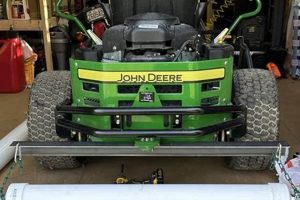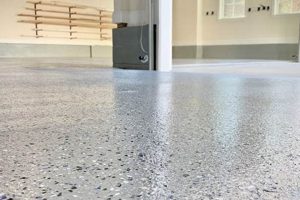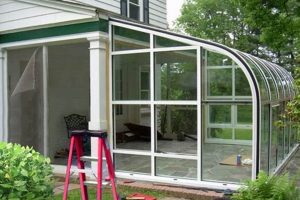A do-it-yourself composite material fabrication package provides the components and instructions necessary for individuals to create custom carbon fiber parts at home or in a small workshop. Such sets typically include carbon fiber fabric, resin, hardener, release agents, and basic tools like brushes and mixing cups. For example, someone might use such a package to create a lightweight fairing for a bicycle or a custom dashboard trim piece for an automobile.
The appeal lies in the ability to produce strong, lightweight components with tailored designs. Historically, carbon fiber fabrication was restricted to industrial settings due to the specialized equipment and knowledge required. The advent of these consumer-oriented packages has democratized access to this advanced material, offering hobbyists, inventors, and small businesses a cost-effective means of prototyping and manufacturing custom parts. The resulting products exhibit a high strength-to-weight ratio, contributing to performance enhancements in various applications.
The subsequent sections will delve into the specific components found within these packages, the methods employed during the fabrication process, and crucial safety precautions to observe while working with the constituent materials. Further discussion will address typical applications and factors to consider when selecting a suitable set for a given project.
Essential Guidelines for Utilizing Composite Material Fabrication Sets
The following guidelines address crucial aspects of working with composite material fabrication sets to ensure optimal results and safe handling of materials.
Tip 1: Material Preparation is Paramount: Prior to commencing any project, meticulously verify the expiration dates of the resin and hardener components. Expired materials may exhibit altered chemical properties, potentially compromising the structural integrity of the final product.
Tip 2: Precise Mixing Ratios are Critical: Adhere strictly to the manufacturer’s specified mixing ratios for resin and hardener. Deviations from these ratios can result in incomplete curing, leading to a weakened or brittle final product. Use calibrated measuring devices to ensure accuracy.
Tip 3: Adequate Ventilation is Mandatory: Resin systems often emit volatile organic compounds (VOCs). Work in a well-ventilated area or utilize a respirator equipped with appropriate organic vapor cartridges to mitigate exposure to these potentially harmful substances.
Tip 4: Fabric Wet-Out Requires Attention: Ensure thorough saturation of the carbon fiber fabric with the resin mixture. Insufficient saturation can lead to dry spots and delamination, weakening the composite structure. Use a brush or roller to evenly distribute the resin.
Tip 5: Controlled Curing is Recommended: While ambient temperature curing is possible, controlled temperature curing in an oven or using a heat lamp can significantly improve the mechanical properties of the composite. Consult the resin manufacturer’s data sheet for recommended curing schedules.
Tip 6: Surface Preparation is Key to Bonding: If bonding the composite part to another surface, proper surface preparation is essential. Abrade the bonding surfaces with sandpaper and clean with a solvent to remove contaminants before applying adhesive.
Tip 7: Proper Mold Release is Crucial: When using a mold, apply a suitable release agent to prevent the composite part from adhering to the mold surface. Thorough and even application of the release agent is critical for easy part removal.
By adhering to these guidelines, users can increase the likelihood of achieving high-quality, structurally sound carbon fiber components while minimizing potential risks associated with the materials and processes involved.
The subsequent sections will cover troubleshooting common issues encountered during composite fabrication and exploring advanced techniques for achieving specialized finishes and properties.
1. Material Selection
The effectiveness of a do-it-yourself carbon fiber kit is directly contingent on the appropriate material selection. The choice of carbon fiber fabric and resin system fundamentally dictates the strength, stiffness, and overall performance of the resulting composite part. Variations in fiber weave patterns, such as plain weave or twill weave, influence the material’s drapability and aesthetic qualities. Similarly, the selection of resin, whether epoxy or polyester, affects factors like curing time, temperature resistance, and chemical compatibility. Inadequate material selection can lead to structural failures, cosmetic defects, or incompatibility issues during the fabrication process. For example, using a low-grade resin with a high-performance carbon fiber fabric would negate the benefits of the expensive fabric. Conversely, using an inappropriate resin system with a specific type of carbon fiber could lead to delamination or a weakened composite structure.
Specific examples demonstrate the practical significance of material selection. When creating a lightweight aerodynamic component for a race car, a high-modulus carbon fiber fabric paired with a high-temperature epoxy resin is essential to withstand extreme operating conditions and maintain structural integrity. For cosmetic applications, like creating decorative trim pieces, a visually appealing carbon fiber weave coupled with a clear, UV-resistant resin is preferred to enhance the aesthetic finish and prevent discoloration over time. Understanding the mechanical properties and limitations of different materials allows the user to tailor the composite part to the specific demands of its intended application. Therefore, material selection represents a pivotal initial decision that governs the entire outcome.
In summary, material selection forms the bedrock of any successful composite fabrication project using a do-it-yourself kit. A thorough understanding of the characteristics and compatibility of various carbon fiber fabrics and resin systems is paramount. While challenges may arise in navigating the wide array of available materials, careful consideration of the intended application and desired performance characteristics is key to achieving optimal results. Correct material choices directly impact durability, aesthetics, and overall project success, linking material understanding to overall diy projects goals.
2. Resin Properties
Resin properties are critical determinants in the performance and workability of materials within a do-it-yourself carbon fiber kit. The resin acts as the matrix, binding the carbon fibers together and transferring loads across them. Understanding resin characteristics is, therefore, fundamental to achieving desired structural and aesthetic outcomes.
- Viscosity
Viscosity refers to the resin’s resistance to flow. Lower viscosity resins penetrate carbon fiber fabrics m
ore easily, ensuring thorough wet-out and minimizing air voids. High viscosity resins, conversely, may struggle to fully saturate the fabric, leading to weaker, more porous composites. Proper wet-out is essential for maximizing the composite’s strength and preventing delamination. For example, a low-viscosity epoxy is often preferred for intricate molds or tightly woven fabrics. - Cure Time and Temperature
Cure time and temperature define the duration and temperature required for the resin to fully harden. Shorter cure times can expedite projects but may limit working time, while longer cure times allow for more complex layups but require extended mold occupancy. Elevated curing temperatures can enhance mechanical properties but demand specialized equipment. Matching the resin’s cure profile to the project’s complexity and available resources is crucial. Some resins cure at room temperature, while others require oven curing to reach their optimal strength.
- Hardness and Flexibility
Hardness and flexibility represent opposing mechanical properties that influence the composite’s resistance to deformation and fracture. A hard resin yields a stiff, rigid composite, suitable for load-bearing applications. A flexible resin provides greater impact resistance and durability in dynamic environments. The resin choice must align with the intended application; a hard resin might be selected for a structural component, while a flexible resin would be chosen for a part subjected to vibrations or impacts.
- Chemical Resistance
Chemical resistance dictates the resin’s ability to withstand exposure to various solvents, fuels, and other chemicals. Carbon fiber parts used in automotive or aerospace applications require resins with high chemical resistance to prevent degradation from exposure to harsh fluids. Selecting a chemically resistant resin is particularly important when the finished component will encounter potentially corrosive environments.
The careful selection of resin based on its viscosity, cure characteristics, hardness, flexibility, and chemical resistance is essential for achieving optimal results with a do-it-yourself carbon fiber kit. Understanding these properties allows users to tailor the composite material to the specific requirements of their project, ensuring both structural integrity and longevity. Different resin systems influence project design and execution.
3. Fabrication Techniques
The success of any project employing a do-it-yourself carbon fiber kit hinges critically on the applied fabrication techniques. The inherent properties of carbon fiber composites necessitate meticulous attention to detail throughout the layup and curing processes. Proper execution of these techniques directly influences the structural integrity, surface finish, and overall quality of the final product.
- Wet Layup
Wet layup involves saturating the carbon fiber fabric with resin directly within the mold. This technique is commonly used due to its relative simplicity and minimal equipment requirements. However, achieving consistent resin distribution and minimizing air voids requires careful attention and practice. Variations in resin application can lead to localized weaknesses or surface imperfections in the finished part. For example, insufficient resin application can result in dry spots, while excessive resin can lead to a heavier, more brittle composite.
- Vacuum Bagging
Vacuum bagging employs a vacuum pump to apply uniform pressure to the carbon fiber layup during the curing process. This pressure compacts the layers of fabric, removes excess resin, and eliminates air voids, resulting in a stronger, lighter, and more consistent composite part. Vacuum bagging is particularly beneficial for complex shapes or parts requiring high structural performance. In automotive applications, vacuum bagging is often used to produce lightweight body panels with improved aerodynamic properties.
- Resin Infusion
Resin infusion, also known as vacuum infusion, involves placing dry carbon fiber fabric into a mold, sealing it with a vacuum bag, and then drawing resin through the fabric using vacuum pressure. This technique offers several advantages, including reduced resin waste, improved fiber-to-resin ratio, and minimal air voids. Resin infusion is suitable for producing large, complex parts with consistent thickness and high structural integrity. In marine applications, resin infusion is frequently used to fabricate large boat hulls and decks.
- Prepreg Layup
Prepreg, or pre-impregnated, carbon fiber fabric comes pre-saturated with resin. This offers precise control over the resin content and eliminates the need for manual resin application. Prepreg layup typically requires refrigerated storage and specialized curing equipment, such as an autoclave or oven. The resulting composite parts exhibit exceptional strength, stiffness, and surface finish. Prepreg is commonly used in aerospace applications where performance is paramount.
In conclusion, the choice of fabrication technique for a do-it-yourself carbon fiber kit project depends on factors such as the complexity of the part, the desired mechanical properties, and the available equipment. While wet layup offers simplicity and affordability, vacuum bagging, resin infusion, and prepreg layup provide superior performance and control. Careful selection and execution of the appropriate fabrication technique are essential for achieving optimal results and realizing the full potential of carbon fiber composites.
4. Curing Process
The curing process is an indispensable stage in the utilization of a do-it-yourself carbon fiber kit, representing the chemical transformation whereby the liquid resin matrix solidifies, binding the carbon fibers together to form a rigid, structural composite. Deviations from prescribed curing parameters directly affect the material’s ultimate mechanical properties. For instance, inadequate curing can result in a composite with reduced strength and stiffness, rendering it unsuitable for load-bearing applications. Conversely, excessive curing can lead to embrittlement and cracking. The duration, temperature, and pressure applied during curing are critical factors that must align with the resin manufacturer’s specifications to ensure proper crosslinking and complete polymerization. Without proper curing, the full potential of the carbon fiber reinforcement remains unrealized, diminishing the structural benefits offered by this advanced material. Real-world examples underscore this importance: a poorly cured carbon fiber bicycle frame may fail under stress, while a properly cured frame exhibits exceptional durability and performance.
The practical significance of understanding the curing process extends to various aspects of composite fabrication. Accurate temperature control is essential, often necessitating the use of ovens or heat lamps to maintain optimal curing conditions. Furthermore, the monitoring of resin exotherm (heat generated during the curing reaction) is crucial to prevent overheating and potential degradation of the composite. Post-curing, a secondary heat treatment, can further enhance the material’s properties by promoting additional crosslinking and relieving residual stresses. In the construction of high-performance automotive components, for examp
le, a precise curing schedule is implemented to maximize the strength-to-weight ratio of carbon fiber body panels, thereby improving vehicle performance and fuel efficiency. Incorrect curing methods not only compromise structural integrity but also affect the aesthetic qualities of the finished product.
In summary, the curing process is not merely a passive step in the composite fabrication workflow; it is an active and influential variable that demands meticulous attention. Challenges in achieving consistent and uniform curing can arise due to variations in ambient temperature, resin batch inconsistencies, or inadequate equipment. Adherence to recommended curing schedules, careful monitoring of process parameters, and appropriate post-curing treatments are essential to unlock the full performance potential of carbon fiber composites created with a do-it-yourself kit. Mastering the nuances of curing establishes a direct link to the overall quality and reliability of the finished product.
5. Finishing Methods
Finishing methods represent the crucial final stages in any do-it-yourself carbon fiber kit project. These techniques transform a raw, fabricated composite part into a polished, functional, and aesthetically pleasing component. The selection and execution of appropriate finishing methods directly impact the part’s appearance, durability, and resistance to environmental factors.
- Sanding and Surface Preparation
Sanding removes imperfections, such as resin drips, surface irregularities, and tooling marks, creating a smooth, uniform surface for subsequent finishing steps. Progressively finer grits of sandpaper are used to refine the surface, culminating in a polished finish. Proper surface preparation is essential for ensuring proper adhesion of paints, clear coats, and other protective coatings. For example, a poorly sanded surface will result in uneven paint coverage and potential delamination of the coating. The quality of the sanding process directly affects the final aesthetic result, linking proper execution to achieving professional finishes.
- Priming and Painting
Priming provides a uniform base for paint, improving adhesion and color consistency. Applying multiple thin coats of primer ensures complete coverage and minimizes the risk of runs or drips. Painting adds color, enhances the aesthetic appeal, and provides a protective layer against UV radiation and chemical exposure. The choice of paint type depends on the intended application and desired finish. Automotive-grade paints, for example, offer superior durability and resistance to weathering. Proper masking techniques are essential for achieving clean lines and preventing overspray, thus proper steps will assure the desired project outcome.
- Clear Coating
Clear coating enhances the visual depth of the carbon fiber weave, protects the paint from scratches and UV damage, and adds a glossy or matte finish. Applying multiple coats of clear coat, followed by wet sanding and polishing, creates a show-quality finish. The selection of clear coat should consider its UV resistance, chemical resistance, and compatibility with the underlying paint. High-quality clear coats provide long-lasting protection and maintain the aesthetic appearance of the carbon fiber part over time. Correct choice provides proper product longevity.
- Polishing and Buffing
Polishing and buffing remove swirl marks, scratches, and other minor imperfections from the clear coat, creating a smooth, reflective surface. Polishing compounds and buffing pads of varying abrasiveness are used to achieve the desired level of gloss. Polishing also enhances the clarity and depth of the carbon fiber weave, highlighting its unique visual characteristics. The final polish adds visual appeal of the final product, maximizing aesthetics.
In conclusion, finishing methods are integral to the successful completion of any do-it-yourself carbon fiber kit project. From sanding and priming to painting, clear coating, and polishing, each step plays a vital role in achieving a high-quality, visually appealing, and durable composite part. While challenges may arise in mastering these techniques, careful attention to detail and proper execution are essential for realizing the full potential of carbon fiber composites. Mastering final steps impacts overall success.
Frequently Asked Questions About Composite Material Fabrication Sets
The following addresses common inquiries regarding the utilization of composite material fabrication sets, providing succinct and informative answers.
Question 1: What is the typical lifespan of the resin and hardener components within a set?
The shelf life of resin and hardener varies depending on the specific chemical composition and storage conditions. Most manufacturers provide an expiration date printed on the packaging. Generally, unopened containers stored in a cool, dry place can maintain usability for one to two years. Once opened, the lifespan may decrease significantly due to exposure to air and moisture.
Question 2: Is specialized equipment mandatory for achieving satisfactory results with these sets?
While advanced equipment like vacuum pumps and autoclaves can enhance the quality of the finished composite part, they are not strictly mandatory for basic projects. Wet layup techniques, which require minimal specialized equipment, can yield acceptable results for many applications. However, the use of vacuum bagging is strongly recommended for more complex or structurally demanding projects.
Question 3: What safety precautions should be observed when working with composite materials?
Safety precautions include wearing appropriate personal protective equipment (PPE) such as gloves, respirators, and eye protection. Work in a well-ventilated area to minimize exposure to volatile organic compounds (VOCs) emitted by the resin. Avoid skin contact with resin and hardener, and promptly clean any spills with appropriate solvents. Consult the manufacturer’s safety data sheets (SDS) for detailed information on specific hazards and handling procedures.
Question 4: How does the choice of carbon fiber weave pattern affect the properties of the finished composite?
Different weave patterns offer varying degrees of drapability, strength, and aesthetic appeal. Plain weave provides a balanced strength profile in both directions and is relatively easy to handle. Twill weave offers greater drapability, conforming well to complex shapes, and exhibits a distinctive diagonal pattern. Satin weave provides a smoother surface finish but may be more prone to distortion during layup.
Question 5: Can composite material fabrication sets be used to repair existing carbon fiber parts?
Yes, these sets can be used for repairing damaged carbon fiber parts, provided the damage is not too extensive. The repair process typically involves removing the damaged material, preparing the surface, applying new carbon fiber and resin, and curing the repair. Proper surface preparation and bonding techniques are crucial for ensuring a strong and durable repair.
Question 6: What factors should be considered when selecting a composite material fabrication set for a specific project?
Factors to consider include the size and complexity of the project, the desired mechanical properties of the finished part, the available equipment, and the user’s skill level. Select a set that contains sufficient materials for
the intended project and includes clear and comprehensive instructions. Consider the resin’s cure time, viscosity, and chemical resistance to ensure it is suitable for the application.
In summary, working with composite material fabrication sets requires careful planning, attention to detail, and adherence to safety guidelines. Informed decision-making regarding material selection and fabrication techniques is essential for achieving optimal results.
The subsequent section will provide guidance on troubleshooting common issues encountered during composite material fabrication.
diy carbon fiber kit
This exploration has detailed the components, techniques, and critical considerations involved in utilizing a diy carbon fiber kit. From material selection and resin properties to fabrication methods, curing processes, and finishing techniques, the importance of each stage in achieving desired results has been emphasized. Adherence to best practices and a thorough understanding of material behavior are paramount for successful project outcomes.
The effective application of a diy carbon fiber kit empowers individuals and small businesses to create custom, high-performance components. Continued advancements in material science and fabrication techniques promise to further expand the possibilities and applications of these versatile materials. Investigate relevant sources prior to embarking on complex or critical projects to enhance project prospects.







